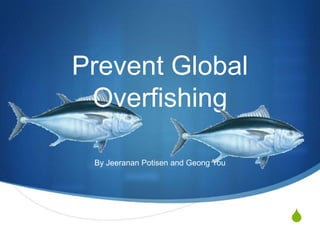
Prevent Global Overfishing of Endangered Bluefin Tuna
- 1. Prevent Global Overfishing By Jeeranan Potisen and Geong You S
- 2. Bluefin Tuna S Scientific name: Thunnus Thynnus S They are warm blooded. S Size: Maximum length is 180 inches total length. Adult Bluefin tuna weight from 300 pounds to 1500 pounds. S Habitat: they come near shore seasonally. It can endure range of temperatures both above and below, down to depth of greater than 3000 feet. Located in the Mediterranean sea; Iceland to the Canary Islands and Newfoundland, Canada to the Gulf of Mexico. S Predators: killer whales and sharks S Feeding habits: they feed on squid, eels, crustaceans, mackerel, flying fish, herring, whiting and mullet.
- 3. Bluefin Tuna (Thunnus S thynnus) Distributed throughout Atlantic and Pacific Oceans in subtropical and temperate waters. In the western Atlantic Ocean, it is found from Labrador, Canada, to northern Brazil, including the Gulf of Mexico. In the eastern Atlantic Ocean, it is found from Norway to the Canary Islands. In the western Pacific Ocean, it is distributed from Japan to the Philippines. In the eastern Pacific Ocean, it is distributed from the southern coast of Alaska, USA to Baja California, Mexico.
- 4. Abundance S Between 1970 and 1998, there was 70% drop of bluefin tuna. This shows the rapid decline. S In 2009, there was 72% decline in the Eastern Atlantic and 82% decline in Western Atlantic. S Atlantic bluefin tuna numbers have dropped 96.4%, due to overfishing.
- 5. Species life history S Spawning in the Gulf of Mexico occurs between mid-April and mid- June when females, which mature around age 8, release approximately 30 million eggs each. The highest density of bluefin larvae, the primary indicator of spawning, occurs in the northern Gulf of Mexico with lesser larval concentrations appearing off the Texas coast and in the Straits of Florida. S In the eastern Atlantic, spawning occurs exclusively in the Mediterranean and Adriatic Seas from June through August, with the highest larvae concentrations appearing around southern Italy. Although some fishery biologists believe that eastern Atlantic bluefin reach sexual maturity several years earlier than western Atlantic bluefin (possibly as young as ages 4-5), this understanding has been criticized.
- 6. Continued… S In the upper layer of water where wind and wave action keeps temperatures uniform. Once they are hatched, the young tuna are around 2.5 mm and barely distinguishable from other types of tuna. S As they grow to 12 mm they develop small and often faint pigment patterns on their fins and tail, which help tell the species apart. Beyond 12 mm, secondary pigment patterns develop which again confuse the identity of the species until much later. S As they grow, the young fish move southwards towards major feeding grounds in the colder Southern Ocean. It begins near the spawning ground and is largest in April, right after the spawning period, helps sweep the tuna down from the West Australian coast to the Great Australian Bight and beyond. S Young tuna likes shallow water closer to the shore and also tend to surface more, perhaps to gather certain types of food, to help with body temperature regulation or in response to light and wind conditions. The Great Australian Bight is the main Australian region where young tuna surface, mostly in the period from November to April.
- 7. Reason why it is endangered S Bluefin tuna is highly valued as a food fish around the world. It is sold fresh or frozen. They are especially favored in Japan, where they can pay in a high price in the raw seafood market. A single fish can sell for $45,000 USD. S Lack of management S Illegal fishing
- 8. Continued… S Used for sushi, sashimi and steaks. S Big business in Japan. Japan has bought and frozen over 47 tons of tuna. This is a strategy which anticipates the rise in prices once the species becomes commercially extinct. Each fish is so valuable in the Japanese market that many fishermen are dependent on these catches. S Fish farming, where wild tuna are caught (often as juveniles who will never be able to reproduce) and are fattened up to sell in the market at a high price. Between 4 and 11 kilos of smaller species are required to producer 1 kg of tuna, which has to be fed 3 times a day. Many of the fish farms in Italy are controlled by the mafia. S Companies such as Corporation Mitsubishi and Taiyo are buying and freezing as much bluefin tuna as they can.
- 9. Solution of preventing endangered tuna S Impose strict limits on the Bluefin tuna catch S Ban illegal fishing S Prohibit fish farming
- 10. Money toward PGO S If the bluefin becomes extinct, then it could have major impact on ecosystems of our ocean. Bluefin tuna is part of a large ecosystem. Some other types of fish that depend on Bluefin tuna for a food source will be disappear. Also, animals above the food chain will have to eat other things, which will disrupt the ecosystem and will die out. Moreover, whatever the tuna eats, such as smaller fish or plants will overpopulate the ecosystem.
- 12. Work cite S http://www.flmnh.ufl.edu/fish/Gallery/Descript/BluefinTuna /BluefinTuna.html S http://isc.ac.affrc.go.jp/ S http://www.oceansentry.org/lang-en/bluefin-tuna.html S http://www.guardian.co.uk/environment/2013/jan/09/overfi shing-pacific-bluefin-tuna S http://www.justsportfishing.com/bluefin_tuna.html